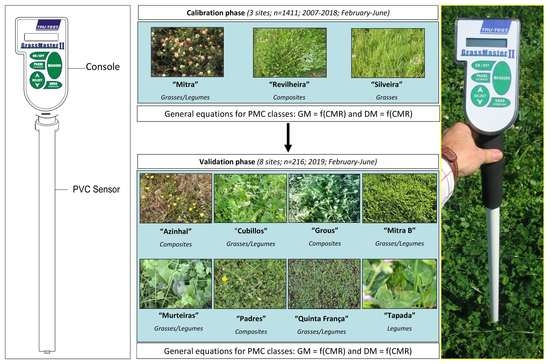Estimation of Productivity in Dryland Mediterranean Pastures: Long-Term Field Tests to Calibration and Validation of the Grassmaster II Probe
Abstract
:1. Introduction
2. Material and Methods
2.1. Characteristics of the Experimental Sites
2.2. Pasture Sampling
2.3. Statistical Analysis
3. Results and Discussions
3.1. Variability Pattern of the Measured Parameters
3.2. Correlations between Pasture Productivity and Grassmaster II Measurements
4. Conclusions
Author Contributions
Funding
Conflicts of Interest
References
- Schaefer, M.T.; Lamb, D.W. A combination of plant NDVI and Lidar measurements improve the estimation of pasture biomass in Tall Fescue (Festuca Arundinacea Var. Fletcher). Remote Sens. 2016, 8, 109. [Google Scholar] [CrossRef] [Green Version]
- Serrano, J.; Shahidian, S.; Da Silva, J.M.; Paixão, L.; Carreira, E.; Pereira, A.; Carvalho, M. Climate changes challenges to the management of Mediterranean montado ecosystem: Perspectives for use of Precision Agriculture technologies. Agronomy 2020, 10, 218. [Google Scholar] [CrossRef] [Green Version]
- Cauduro, G.F.; Carvalho, P.; Barbosa, C.; Lunardi, R.; Pilau, A.; Freitas, F. A comparison of methods used to determine forage mass in italian ryegras pasture (Lolium Multiflorum Lam.). Cienc. Rural 2006, 36, 1617–1623. [Google Scholar] [CrossRef]
- Sanderson, M.A.; Rotz, C.A.; Fultz, S.W.; Rayburn, E.B. Estimating forage mass with a commercial capacitance meter, rising plate meter, and pasture ruler. Agron. J. 2001, 93, 1281–1286. [Google Scholar] [CrossRef] [Green Version]
- Serrano, J.; Peça, J.; da Silva, J.M.; Shahidian, S. Calibration of a capacitance probe for measurement and mapping of dry matter yield in Mediterranean pastures. Precis. Agric. 2011, 12, 860–875. [Google Scholar] [CrossRef]
- Pullanagari, R.R.; Yule, I.J.; Tuohy, M.P.; Hedley, M.J.; Dynes, R.A.; King, W.M. Proximal sensing of the seasonal variability of pasture nutritive value using multispectral radiometry. Grass Forage Sci. 2013, 68, 110–119. [Google Scholar] [CrossRef]
- Nawar, S.; Corstanje, R.; Halcro, G.; Mulla, D.; Mouazen, A.M. Delineation of soil management zones for variable-rate fertilization: A review. Adv. Agron. 2017, 143, 175–245. [Google Scholar]
- Edirisinghe, A.; Hill, M.J.; Donald, G.E.; Hyder, M. Quantitative mapping of pasture biomass using satellite imagery. Int. J. Remote Sens. 2011, 32, 2699–2724. [Google Scholar] [CrossRef]
- Cicore, P.; Serrano, J.; Shahidian, S.; Sousa, A.; Costa, J.L.; da Silva, J.M. Assessment of the spatial variability in tall wheatgrass forage using LANDSAT 8 satellite imagery to delineate potential management zones. Environ. Monit. Assess. 2016, 188, 1–11. [Google Scholar] [CrossRef]
- Louhaichi, M.; Hassan, S.; Clifton, K.; Johnson, D.E. A reliable and non-destructive method for estimating forage shrub cover and biomass in arid environments using digital vegetation charting technique. Agrofor. Syst. 2018, 92, 1341–1352. [Google Scholar] [CrossRef] [Green Version]
- Handcock, R.N.; Gobbett, D.L.; González, L.A.; Bishop-Hurley, G.J.; McGavin, S.L. A pilot project combining multispectral proximal sensors and digital cameras for monitoring tropical pastures. Biogeosciences 2016, 13, 4673–4695. [Google Scholar] [CrossRef] [Green Version]
- Serrano, J.; Shahidian, S.; da Silva, J.M. Calibration of GrassMaster II to estimate green and dry matter yield in Mediterranean pastures: Effect of pasture moisture content. Crop Pasture Sci. 2016, 67, 780–791. [Google Scholar] [CrossRef]
- Vickery, P.J.; Nicol, G.R. An Improved Electronic Capacitance Meter for Estimating Pasture Yield: Construction Details and Performance Tests; Australian Animal Research Laboratories technical paper no. 9; CSIRO: Canberra, Australia, 1982; pp. 1–22. [Google Scholar]
- Virkajarvi, P. Comparison of three indirect methods for prediction of herbage mass on timothymeadow fescue pastures. Soil Plant Sci. 1999, 49, 75–81. [Google Scholar]
- Zanine, A.M.; Santos, E.M.; Ferreira, D.J. Main methodologies for evaluation of pastures. REDVET 2006, 7, 1–13. [Google Scholar]
- Hanna, M.; Steyn-Ross, D.; Steyn-Ross, M. Estimating biomass for New Zealand pasture using optical remote sensing techniques. Geocarto Int. 1999, 14, 89–94. [Google Scholar] [CrossRef]
- Serrano, J.; Shahidian, S.; Moral, F.; da Silva, J.M. Long-term evaluation of the Grassmaster II probe to estimate productivity of pastures. In Precision Agriculture ’19, Proceedings of the 12th European Conference on Precision Agriculture (ECPA2019), Montpellier, France, 8–11 July 2019; John, V., Ed.; Wageningen Academic Publishers: Wageningen, The Netherlands, 2019; pp. 631–637. [Google Scholar]
- Reese, G.; Bayn, R.; West, N. Evaluation of double-sampling estimators of subalpine herbage production. J. Range Manag. 1980, 33, 300–306. [Google Scholar] [CrossRef]
- Karl, M.G.; Nicholson, R.A. Evaluation of the forage disk method in mixed grass rangeland in Kansas. J. Range Manag. 1987, 40, 467–471. [Google Scholar] [CrossRef] [Green Version]
- Aiken, G.E.; Bransby, D.I. Observer variability for disk meter measurements of forage mass. Agron. J. 1992, 84, 603–605. [Google Scholar] [CrossRef]
- Hirata, M. Quantifying spatial heterogeneity in herbage mass and consumption in pastures. J. Range Manag. 2000, 53, 315–321. [Google Scholar] [CrossRef]
- Jamieson, P.D.; Porter, J.R.; Wilson, D.R. A test of the computer simulation model ARCWHEAT1 on wheat crops grown in New Zealand. Field Crop. Res. 1991, 27, 337–350. [Google Scholar] [CrossRef]
- Schellberg, J.; Hill, M.J.; Roland, G.; Rothmund, M.; Braun, M. Precision agriculture on grassland: Applications, perspectives and constraints. Eur. J. Agron. 2008, 29, 59–71. [Google Scholar] [CrossRef]
- Ogura, S.; Hirata, M. Two-dimensional monitoring of spatial distribution of herbage mass in a bahia grass (Paspalum notatum Flugge) pasture grazed with cattle. Grassl. Sci. 2001, 47, 453–459. [Google Scholar]
- Currie, P.O.; Hilken, T.O.; White, R.S. Evaluation of a single probe capacitance meter for estimating herbage yield. J. Range Manag. 1987, 40, 537–541. [Google Scholar] [CrossRef]
- Murphy, W.M.; Silman, J.P.; Barreto, A.D. A comparison of quadrat, capacitance meter, HFRO sward stick, and rising plate meter for estimating herbage mass in a smooth-stalked meadowgrass-dominant white clover sward. Grass Forage Sci. 1995, 50, 452–455. [Google Scholar] [CrossRef]
- O’Donovan, M.; Dillon, P.; Rath, M.; Stakelum, G. A comparison of four methods of pasture mass estimation. Irish J. Agric. Food Res. 2002, 41, 17–29. [Google Scholar]
- Efe Serrano, J. Pastures in Alentejo: Technical Basis for Characterization, Grazing and Improvement; Universidade de Évora: ICAM, Évora, Portugal, 2006; pp. 165–178. [Google Scholar]
- Trotter, M.G.; Lamb, D.W.; Donald, G.E.; Schneider, D.A. Evaluating an active optical sensor for quantifying and mapping green herbage mass and growth in a perennial grass pasture. Crop Pasture Sci. 2010, 61, 389–398. [Google Scholar] [CrossRef]
- King, W.M.; Rennie, G.M.; Dalley, D.E.; Dynes, R.A.; Upsdell, M.P. Pasture mass estimation by the C-DAX Pasture meter: Regional calibrations for New Zealand. In Proceedings of the 4th Australasian Dairy Science Symposium, Lincoln University, Australia, 31 August–2 September 2010; Caxton Press: Christchurch, New Zealand, 2010; pp. 233–238. [Google Scholar]
- Beukes, P.C.; McCarthy, S.; Wims, C.M.; Gregorini, P.; Romera, A.J. Regular estimates of herbage mass can improve profitability of pasture-based dairy systems. Anim. Prod. Sci. 2019, 59, 359–367. [Google Scholar] [CrossRef]
- Legg, M.; Bradley, S. Ultrasonic proximal sensing of pasture biomass. Remote Sens. 2019, 11, 2459. [Google Scholar] [CrossRef] [Green Version]
- Freeman, K.W.; Girma, K.; Arnall, D.B.; Mullen, R.W.; Martin, K.L.; Teal, R.K.; Raun, W.R. By-plant prediction of corn forage biomass and nitrogen uptake at various growth stages using remote sensing and plant height. Agron. J. 2007, 99, 530–536. [Google Scholar] [CrossRef] [Green Version]

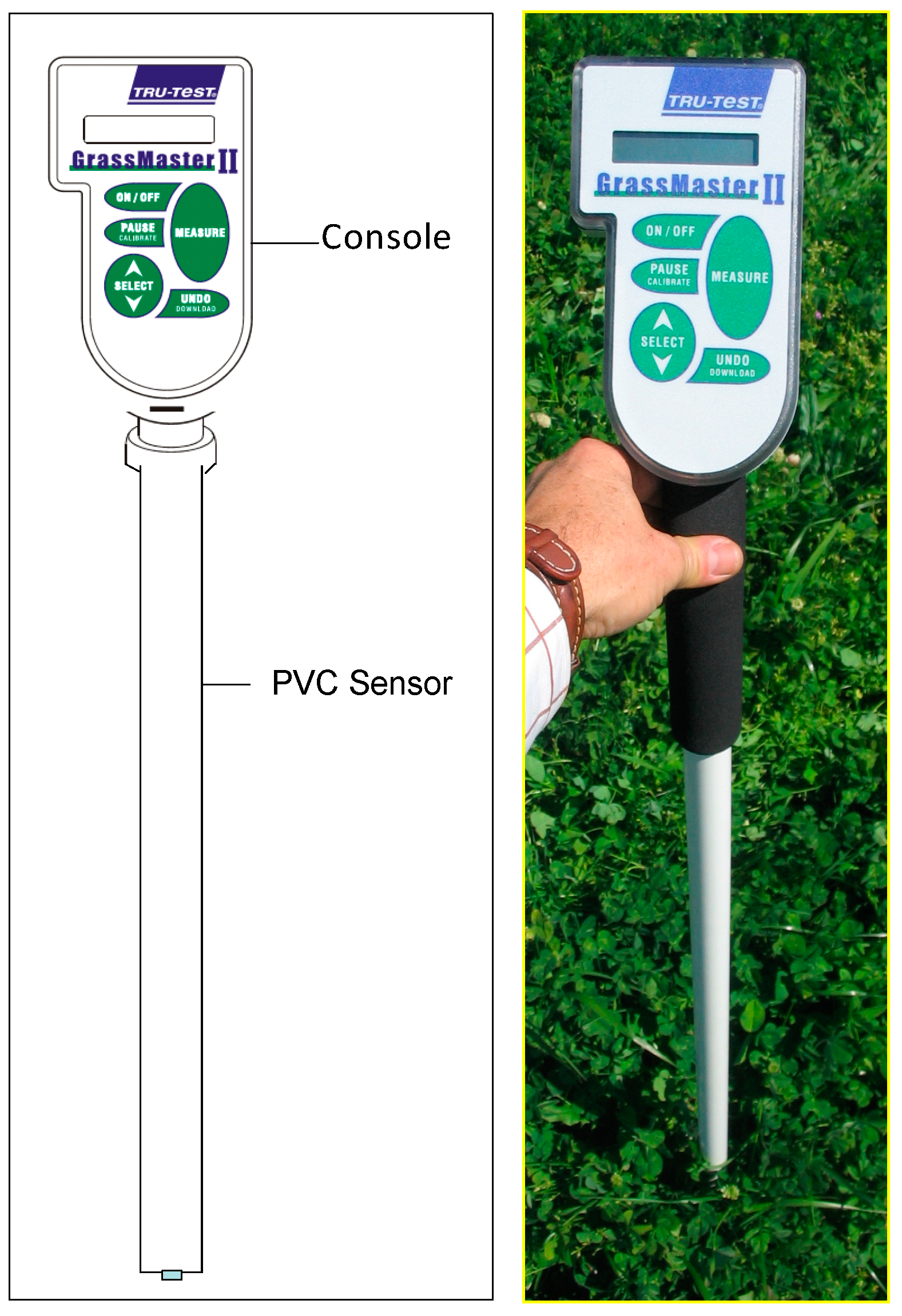
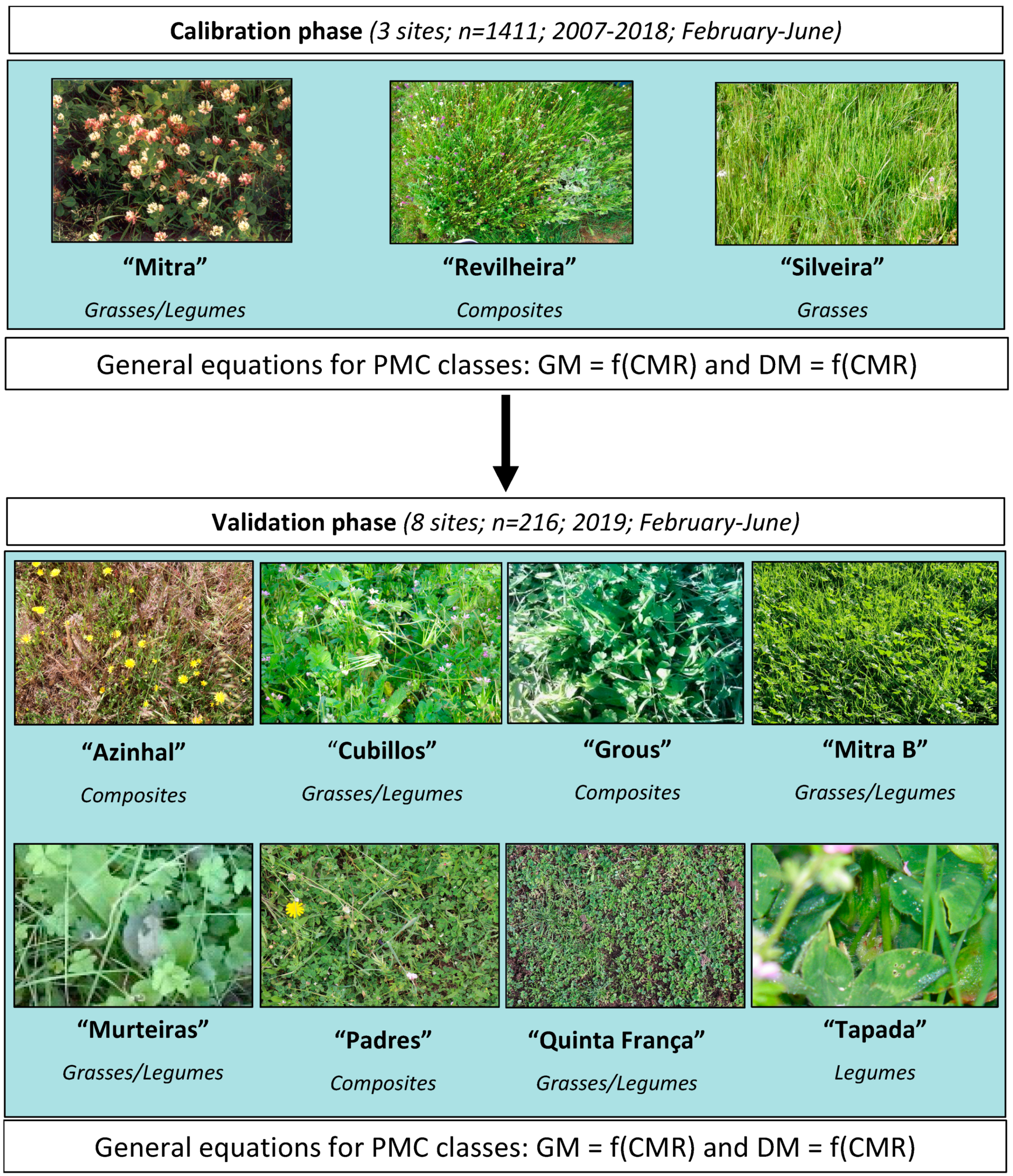
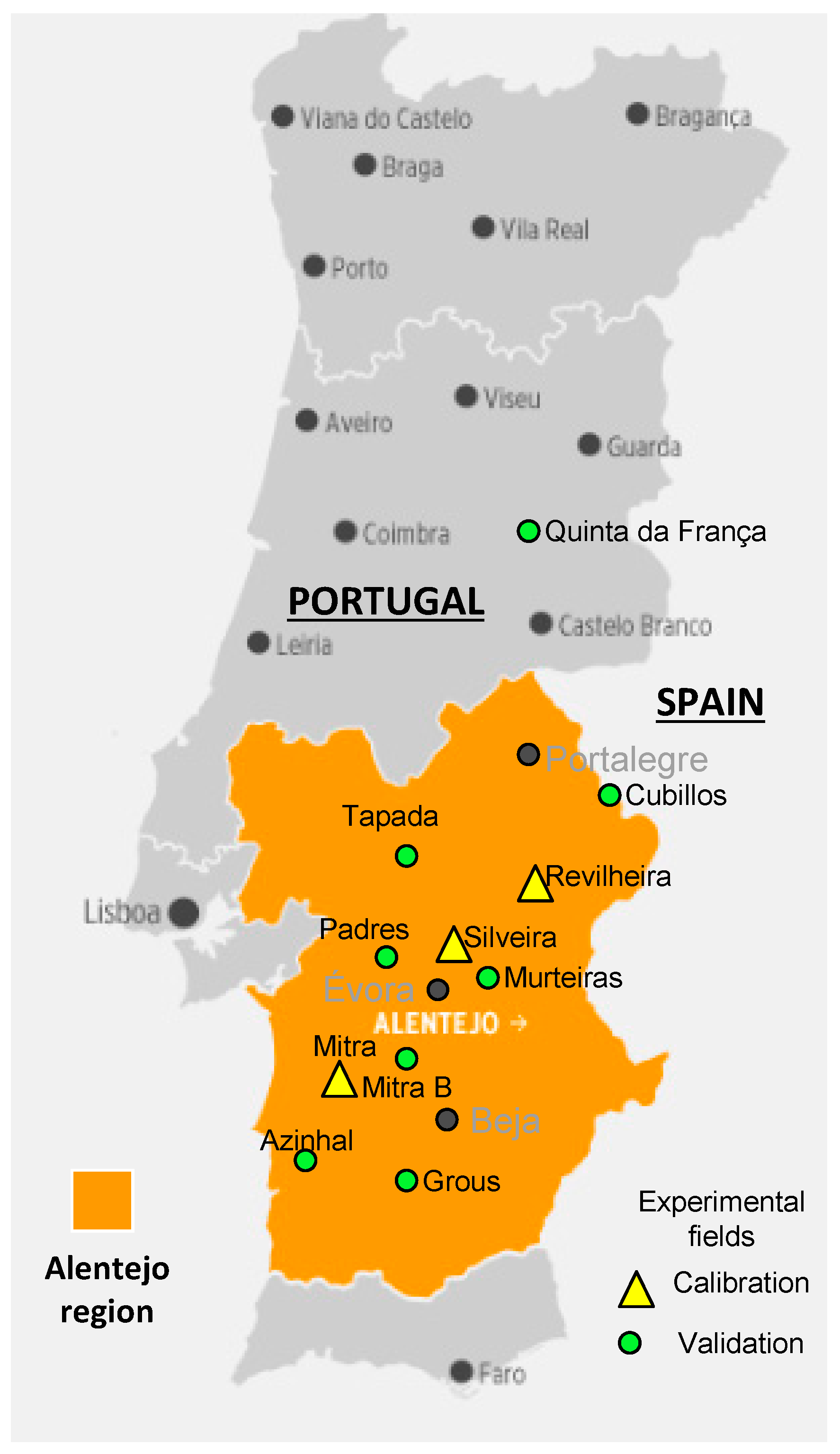
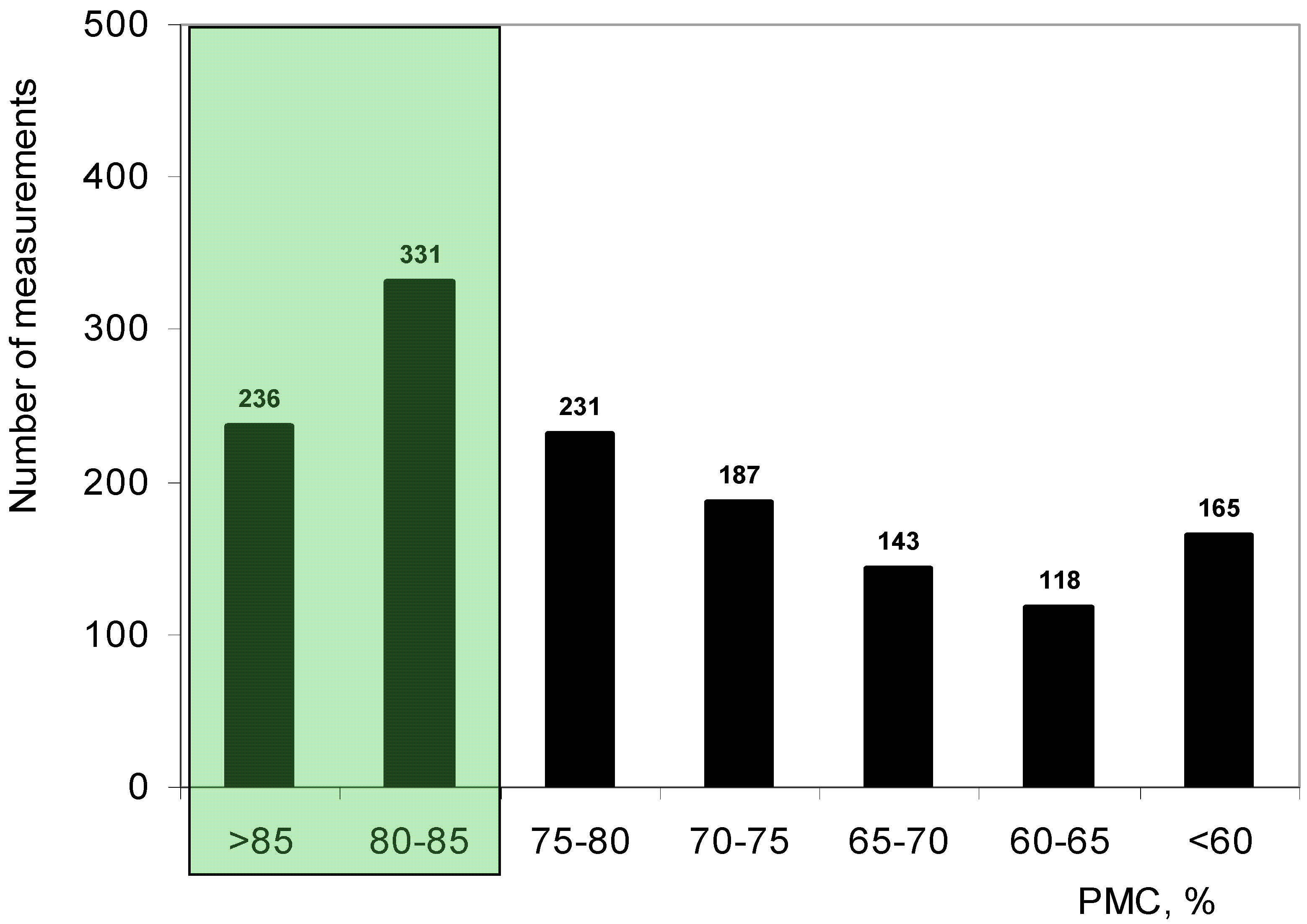
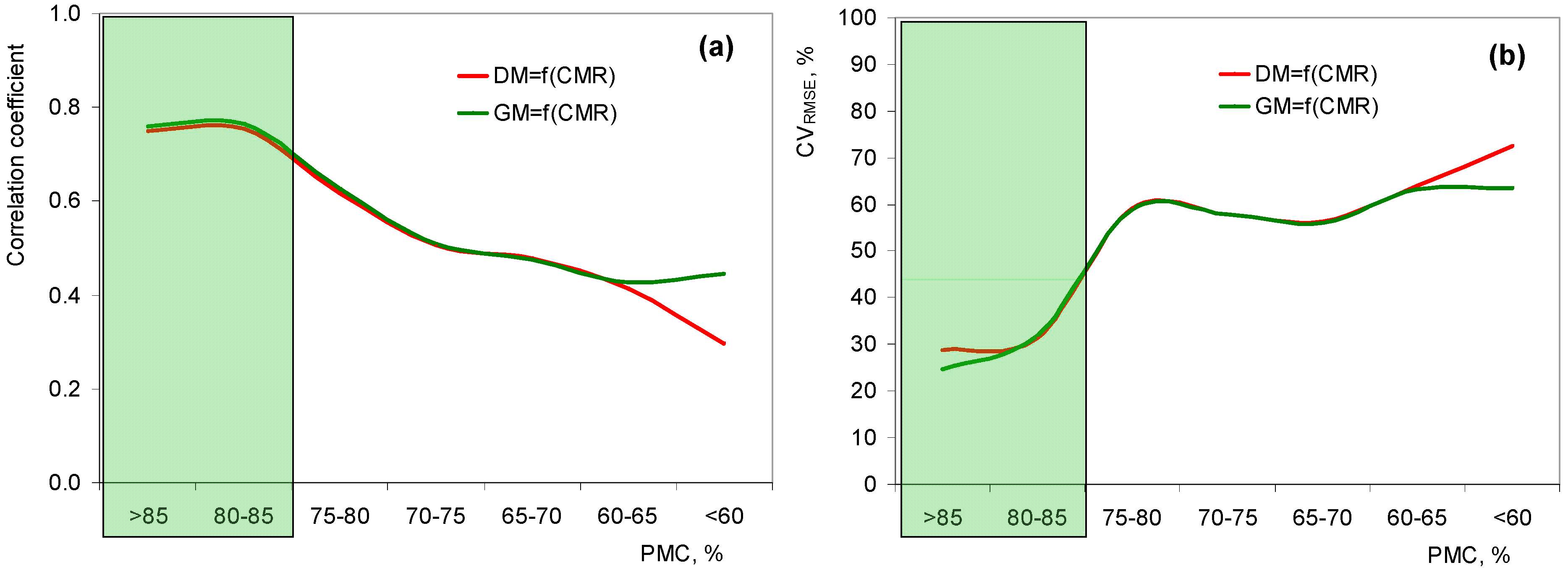
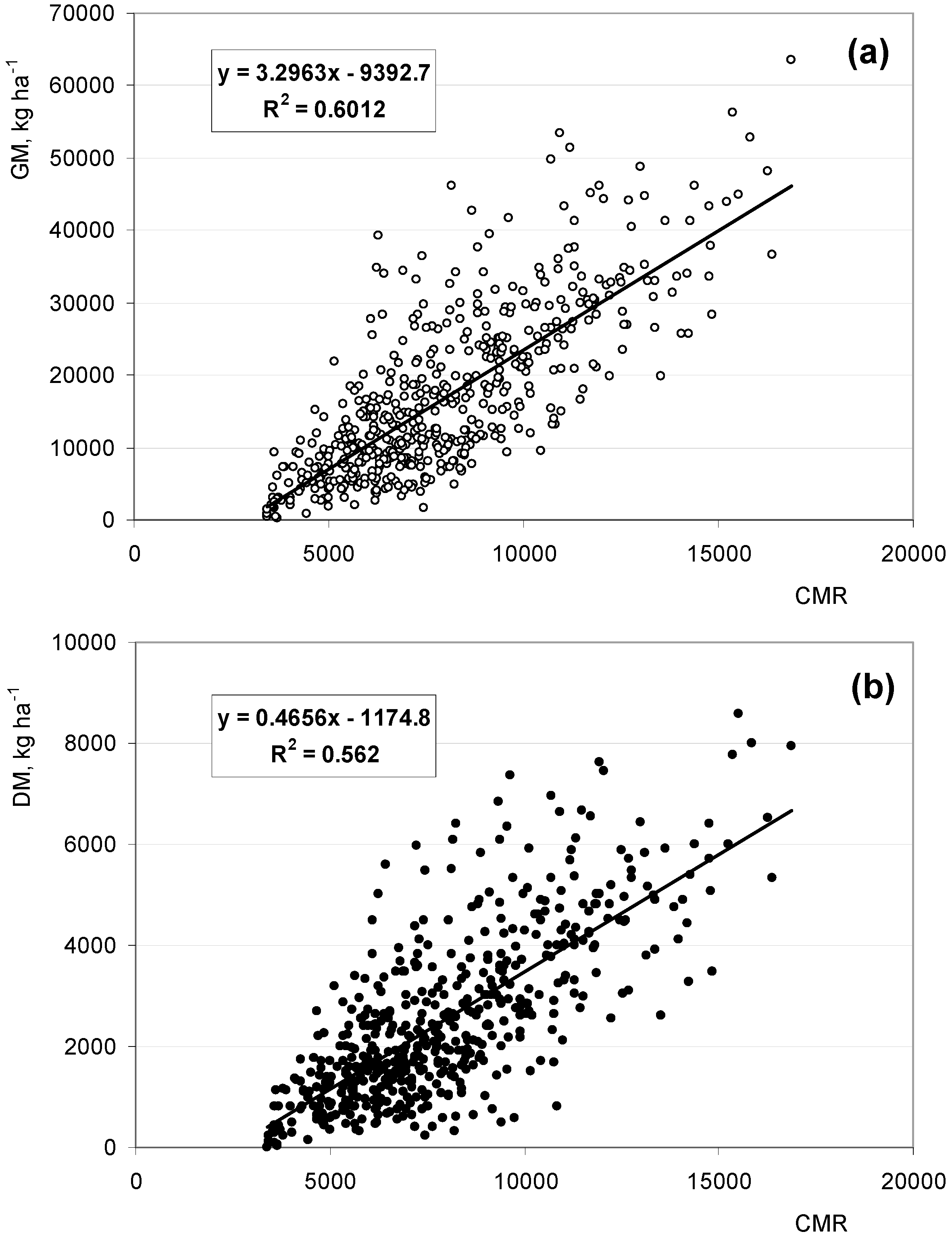
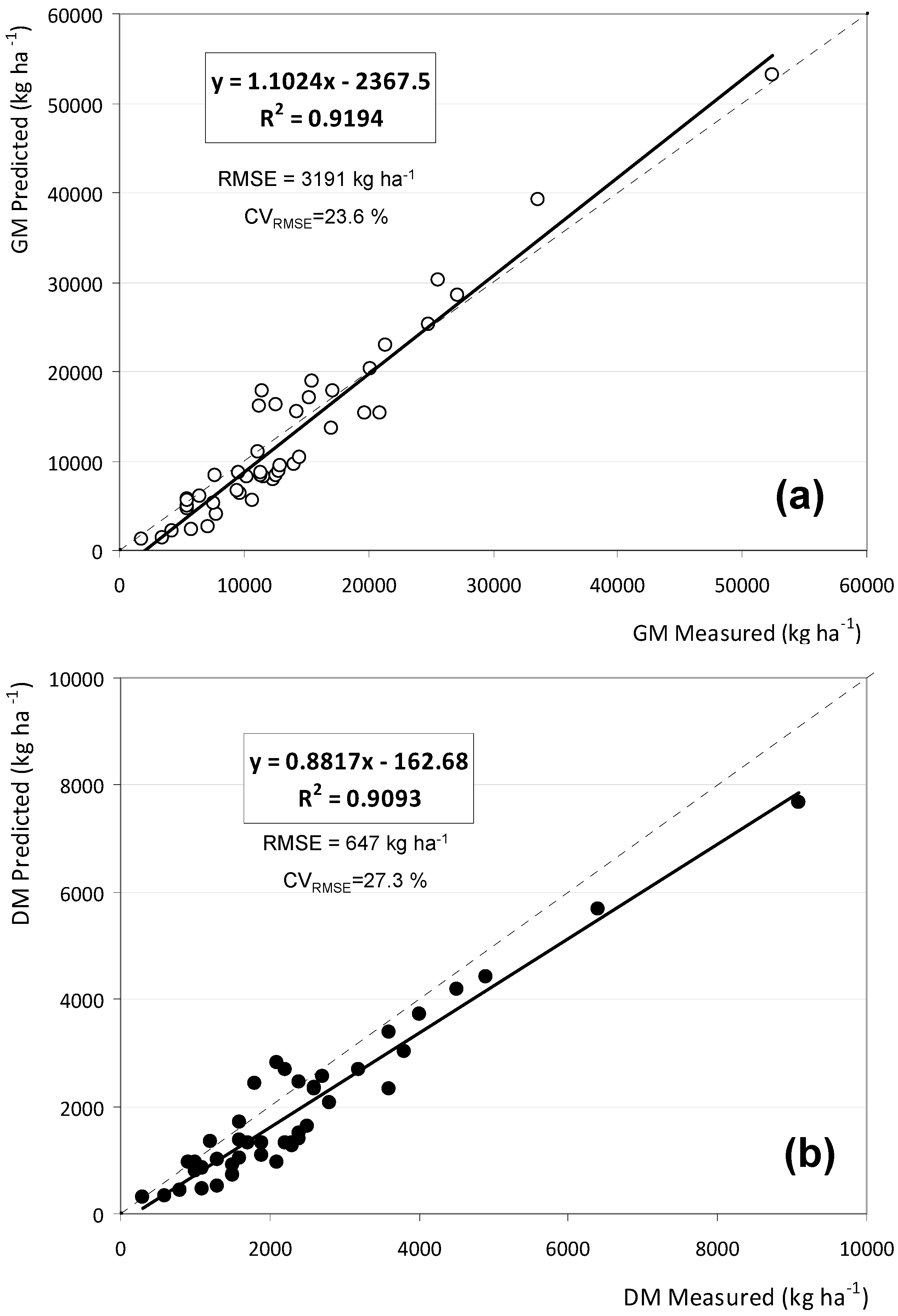



| Site (Number of Samples) | Coordinates | Pasture Type | Predominant Trees | Animal Species | Sampling Years |
|---|---|---|---|---|---|
| “Mitra” (n = 726) | 38°32.2′ N; 8°01.1′ W | Permanent; biodiverse (mixture of grasses and legumes) | Holm oak | Sheep in permanent grazing | 2007; 2013; 2015–2018 |
| “Revilheira” (n = 199) | 38°27.9′ N; 7°25.7′ W | Permanent; biodiverse (predominance of composites) | Holm oak and Cork oak | Sheep in rotational grazing | 2007; 2013 |
| “Silveira” (n = 486) | 38° 62.2′ N; 7°94.8′ W | Permanent; biodiverse (predominance of grasses) | Olive, Holm oak and Mulberries | Sheep in permanent grazing | 2013–2016 |
| “Azinhal” (n = 27) | 38°6.2′ N; 8°26.9′ W | Permanent; biodiverse (predominance of composites) | Holm oak and Cork oak | Sheep in rotational grazing | 2019 |
| “Cubillos” (n = 27) | 39°10.0′ N; 6°44.6′ W | Annual; biodiverse (mixture of grasses and legumes) | Holm oak and Cork oak | Cattle in rotational grazing | 2019 |
| “Grous” (n = 27) | 37°52.3′ N; 7°56.7′ W | Permanent; biodiverse (predominance of composites) | Holm oak | Cattle in rotational grazing | 2019 |
| “Mitra B” (n = 27) | 38°31.8′ N; 8°0.9′ W | Permanent; biodiverse (mixture of grasses and legumes) | Holm oak and Cork oak | Cattle in rotational grazing | 2019 |
| “Murteiras” (n = 27) | 38°23.4′ N; 7°52.5′ W | Annual; biodiverse (mixture of grasses and legumes) | Holm oak and Cork oak | Sheep in permanent grazing | 2019 |
| “Padres” (n = 27) | 38°36.4′ N; 8°8.7′ W | Permanent; biodiverse (predominance of composites) | Holm oak | Cattle in permanent grazing | 2019 |
| “Quinta França” (n = 27) | 40°16.4′ N; 7°25.9′ W | Permanent; biodiverse (mixture of grasses and legumes) | Eucalyptus | Sheep and cattle in rotational grazing | 2019 |
| “Tapada” (n = 27) | 39°9.5′ N; 7°31.9′ W | Permanent; biodiverse (mixture of legumes) | Holm oak and Cork oak | Cattle, sheep or pigs in rotational grazing | 2019 |
| PMC Classes, % | n | CMR | GM, kg ha−1 | DM, kg ha−1 |
|---|---|---|---|---|
| >85 | 236 | 8772 ± 2887 | 23,696 ± 17,570 | 2923 ± 2067 |
| 80–85 | 331 | 7523 ± 2370 | 14,351 ± 9374 | 2444 ± 1564 |
| 75–80 | 231 | 6488 ± 2354 | 11,587 ± 8753 | 2561 ± 1930 |
| 70–75 | 187 | 6428 ± 2429 | 9950 ± 6712 | 2729 ± 1834 |
| 65–70 | 143 | 5727 ± 2624 | 8645 ± 9825 | 2775 ± 1756 |
| 60–65 | 118 | 5645 ± 1726 | 8389 ± 5892 | 3119 ± 2202 |
| <60 | 165 | 4586 ± 1143 | 7023 ± 5089 | 4586 ± 1143 |
| >80 | 567 | 8043 ± 2668 | 17,119 ± 11,341 | 2570 ± 1657 |
| 70–80 | 418 | 6461 ± 2385 | 10,854 ± 7939 | 2636 ± 1887 |
| <70 | 426 | 5262 ± 1631 | 7946 ± 5509 | 3175 ± 2313 |
| PMC, % | n | CMR | GM, kg ha−1 | DM, kg ha−1 |
|---|---|---|---|---|
| >80 | 47 | 6651 ± 3130 | 13,516 ± 8974 | 2364 ± 1576 |
| 70–80 | 98 | 6268 ± 3091 | 11,782 ± 7814 | 2901 ± 1737 |
| <70 | 71 | 4962 ± 1231 | 6154 ± 3955 | 2310 ± 1334 |
| PMC Classes, % | N | Linear Equations | r | RMSE, kg ha−1 | CVRMSE, % |
|---|---|---|---|---|---|
| >85 | 236 | 3.3319 *CMR − 8225.4 | 0.759 ** | 5855 | 24.7 |
| 80–85 | 331 | 3.0236 *CMR − 8395.7 | 0.765 ** | 4597 | 32.0 |
| 75–80 | 231 | 2.3271 *CMR − 3512.4 | 0.626 * | 6813 | 58.8 |
| 70–75 | 187 | 1.4044 *CMR + 922.48 | 0.508 * | 5766 | 57.8 |
| 65–70 | 143 | 1.4915 *CMR + 103.8 | 0.477 * | 4852 | 56.1 |
| 60–65 | 118 | 1.46 *CMR + 146.37 | 0.428 * | 5303 | 63.2 |
| <60 | 165 | 2.1234 *CMR − 2714.2 | 0.445 * | 4460 | 63.5 |
| >80 | 567 | 3.2963 *CMR − 9392.7 | 0.775 ** | 4806 | 28.1 |
| 70–80 | 418 | 1.9042 *CMR − 1449.2 | 0.572 * | 6839 | 63.0 |
| <70 | 426 | 1.5881 *CMR − 411.24 | 0.470 * | 4837 | 60.9 |
| PMC Classes, % | n | Linear Equations | R | RMSE, kg ha−1 | CVRMSE, % |
|---|---|---|---|---|---|
| >85 | 236 | 0.4592 *CMR − 1281.3 | 0.750 ** | 844 | 28.8 |
| 80–85 | 331 | 0.4983 *CMR − 1304.5 | 0.755 ** | 765 | 31.3 |
| 75–80 | 231 | 0.5065 *CMR − 725.1 | 0.618 * | 1515 | 59.2 |
| 70–75 | 187 | 0.3819 *CMR + 274.19 | 0.506 * | 1577 | 57.8 |
| 65–70 | 143 | 0.4829 *CMR + 9.1169 | 0.479 * | 1562 | 56.3 |
| 60–65 | 118 | 0.5279 *CMR + 138.59 | 0.414 * | 1996 | 64.0 |
| <60 | 165 | 0.7052 *CMR + 327.74 | 0.297 ns | 2581 | 72.5 |
| >80 | 567 | 0.4656 *CMR − 1174.8 | 0.750 ** | 763 | 29.7 |
| 70–80 | 418 | 0.4483 *CMR − 260.57 | 0.567 * | 1543 | 58.5 |
| <70 | 426 | 0.4222 *CMR + 953.26 | 0.298 ns | 2122 | 66.8 |
© 2020 by the authors. Licensee MDPI, Basel, Switzerland. This article is an open access article distributed under the terms and conditions of the Creative Commons Attribution (CC BY) license (http://creativecommons.org/licenses/by/4.0/).
Share and Cite
Serrano, J.; Shahidian, S.; Moral, F.; Carvajal-Ramirez, F.; Marques da Silva, J. Estimation of Productivity in Dryland Mediterranean Pastures: Long-Term Field Tests to Calibration and Validation of the Grassmaster II Probe. AgriEngineering 2020, 2, 240-255. https://doi.org/10.3390/agriengineering2020015
Serrano J, Shahidian S, Moral F, Carvajal-Ramirez F, Marques da Silva J. Estimation of Productivity in Dryland Mediterranean Pastures: Long-Term Field Tests to Calibration and Validation of the Grassmaster II Probe. AgriEngineering. 2020; 2(2):240-255. https://doi.org/10.3390/agriengineering2020015
Chicago/Turabian StyleSerrano, João, Shakib Shahidian, Francisco Moral, Fernando Carvajal-Ramirez, and José Marques da Silva. 2020. "Estimation of Productivity in Dryland Mediterranean Pastures: Long-Term Field Tests to Calibration and Validation of the Grassmaster II Probe" AgriEngineering 2, no. 2: 240-255. https://doi.org/10.3390/agriengineering2020015






